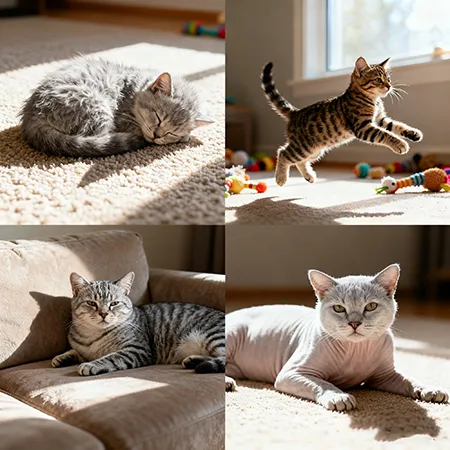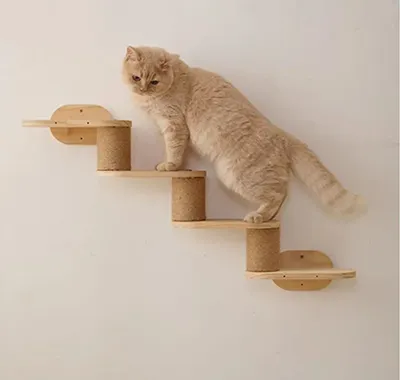購物車
您的購物車還沒有商品!

Have you ever stared at your purring cat and thought, “Just how old are you in ‘cat terms’?” For years, the “multiply by seven” trick has been a quick answer—but it’s not accurate. Cats grow fast, and each life stage comes with unique needs. To keep your feline friend happy and healthy, you need to match their care to their real cat age. Below, we break down four key life stages (with human-to-cat year conversions), and cover everything from detailed feeding amountsto specific exercise methods—plus vet care and gear tips.
This is when your tiny furball grows from a helpless newborn to a curious “teenager” in 12 months. Rapid physical and mental development means precise care is critical.
Kittens need calorie-dense, nutrient-rich food to fuel growth—opt for a high-quality kitten formula (minimum 30% protein, 20% fat, and 0.1% DHA for brain/eye health). Feeding amounts vary by weight and age:
0–3 months: 80–120 kcal per kg of body weight daily. For a 0.5kg kitten, this equals 40–60 kcal/day (about 15–25g of dry kitten food), split into 6–8 small meals (every 2–3 hours).
3–6 months: 70–100 kcal per kg daily. A 1kg kitten needs 70–100 kcal/day (25–35g of dry food), divided into 4–6 meals (every 3–4 hours).
6–12 months: 60–80 kcal per kg daily. A 2kg kitten requires 120–160 kcal/day (40–55g of dry food), given in 3–4 meals (every 4–6 hours).Avoid free-feeding—scheduled meals help track appetite and prevent overeating. If using wet food, mix 1 part wet (50–70kcal/50g) with 2 parts dry to balance nutrition.
Use a shallow bowl (1–2 inches deep) to avoid overwhelming kittens. Refill 2–3 times daily and wash with mild soap to prevent bacteria. For reluctant drinkers, add a drop of low-sodium chicken broth (cooled) to entice them—aim for 50–70ml of water per kg of body weight daily.
Kittens sleep 16–20 hours/day to support growth. Provide a soft, warm bed (e.g., a lined basket with a fleece blanket) in a quiet corner, away from TVs or foot traffic. In winter, place a low-wattage heating pad (covered) under half the bed—ensure they can move away if overheated.
Focus on short, frequent sessions to avoid tiring their developing bodies:
0–3 months: 2–3 sessions of 3–5 minutes/day. Use soft toys (plush mice, rubber balls no smaller than a ping-pong ball) for gentle pouncing. Avoid laser pointers—they can cause frustration without a “catch.”
3–6 months: 3–4 sessions of 5–8 minutes/day. Add feather wands or crinkle sticks, moving toys in slow, erratic motions to mimic bugs. Introduce a small cat tunnel for exploration.
6–12 months: 2–3 sessions of 8–10 minutes/day. Use puzzle feeders (hide 1–2 kibbles inside) to combine play with mental stimulation. Encourage climbing on a multi-tiered cat tree with sisal posts—this builds coordination and redirects scratching.
Reward calm behavior (e.g., using the litter box) with tiny treats (1–2 calories each) or verbal praise. Introduce 1 new experience weekly:
Let gentle adults hold them for 1–2 minutes (support their body).
Play soft sounds (vacuum, doorbell) at low volume while giving treats.
Redirect furniture scratching to a sisal-post cat tree ,4-Tier Cat Tree Condo with sisal posts—rub catnip on the posts to attract them.
Visit the vet at 8, 12, and 16 weeks for core vaccinations (distemper, calicivirus, rhinotracheitis) and rabies (at 12 weeks). The vet will deworm for roundworms/hookworms and discuss spaying/neutering (around 6 months, when they reach 2kg). Weigh them weekly—healthy growth is 50–100g/week.
Your kitten is now a young adult—physically mature but still energetic. This phase is key for preventing obesity and reinforcing good habits.
Switch to adult cat food (25–30% protein, 10–15% fat) to avoid excess calories. Feeding amounts depend on activity level and weight:
Indoor/low activity (e.g., naps most days): 40–50 kcal per kg daily. A 3kg cat needs 120–150 kcal/day (40–50g of dry food).
Indoor/moderate activity (1–2 play sessions/day): 50–60 kcal per kg daily. A 3kg cat requires 150–180 kcal/day (50–60g of dry food).
Outdoor/active (hunts or plays frequently): 60–70 kcal per kg daily. A 3kg cat needs 180–210 kcal/day (60–70g of dry food).Feed 2 measured meals/day (7 AM and 7 PM) using a kitchen scale—cups vary in volume. Limit treats to 5–10% of daily calories (e.g., 2–3 freeze-dried chicken pieces).
Place 2–3 bowls around the home (near food, bed, and play areas). For picky drinkers, use a cat water fountain,Healthy Hydration for Cats – Smart Fountain with Triple Filtration System—moving water encourages 20–30% more intake, supporting kidney health. Clean the fountain weekly to prevent algae.
Juniors sleep 12–16 hours/day. Provide a cozy bed in a sunny spot (cats prefer 25–28°C) or a quiet nook. A bed with a raised edge offers security—choose breathable fabric (cotton) to avoid overheating.
Aim for 20–30 minutes of daily interactive play, split into 2 sessions:
Prey-mimicking play: Use laser pointers (always end with a plush toy “catch” to avoid frustration) or wand toys with fur attachments. Move toys in quick bursts (dart under couches, pop up suddenly) to mimic mice.
Climbing/jumping: Set up a small obstacle course—pillow on the floor → low stool → wall-mounted climbing system. Encourage jumps of 6–12 inches (avoid higher jumps to protect joints).

Climbing Wall Cat Shelf for Heavy Cats
Mental stimulation: Rotate toys every 2–3 days (hide unused ones) to prevent boredom. Use treat-dispensing balls that require rolling to release kibbles.
Reinforce scratching habits by placing a Wall-Mounted Cat Climbing Wall (4–5 feet tall, with 2–3 platforms) near furniture they’ve targeted .Reward use with treats. If they chew cords, cover them with bitter-tasting deterrent spray and offer chew toys (rubber dental toys) instead.
Schedule an annual check-up. The vet will:
Weigh your cat—target body condition score (BCS) is 5/9 (ribs palpable but not visible).
Check teeth for tartar—start brushing 2–3 times/week with cat-specific toothpaste (use a finger brush for beginners).
Update booster shots (distemper/rabies) and test for heartworms (if outdoor).
Your cat is in their prime—calm, routine-driven, and with a fully formed personality. Focus on maintaining health and comfort.
Stick to adult food, but adjust portions for weight:
Ideal weight (3–4kg for domestic cats): 40–60 kcal per kg daily (follow activity guidelines from the junior phase).
Weight gain: Reduce portions by 5–10% (e.g., 50g → 45g of dry food) and switch to low-calorie adult food (25–28% protein, 8–10% fat).
Weight loss: Add 10–15g of wet food (50–70kcal/50g) to dry meals—wet food is more palatable and boosts hydration.Feed at the same times daily (e.g., 7 AM, 7 PM) to maintain routine. Avoid human food (dairy, chocolate, onions) as it’s toxic.
Keep bowls clean (wash daily) and refill 2–3 times/day. Some cats prefer ceramic/stainless steel bowls (plastic harbors odors). If water intake drops below 40ml/kg, add a splash of tuna water (drained from canned tuna in water) to bowls.
Adults sleep 12–16 hours/day, often napping in sunny spots. Provide a soft bed with a blanket (preferably one that smells like you) —choose a round bed for curled-up sleep or rectangular for stretching. Place beds away from drafts (windows in winter, AC in summer).
Focus on “quality over quantity”—15–20 minutes/day, 1–2 sessions (evening is best, as cats are crepuscular):
Low-intensity play: Toss soft toys (crinkle balls, stuffed mice) 1–2 feet—let them bat and carry toys to satisfy hunting instincts.
Interactive play: Use a wand toy with a fleece mouse attachment—move slowly to mimic a tired prey animal, so they can “catch” easily. Praise them for pouncing.
Environmental enrichment: Install a secure wooden cat window perch (weight capacity ≥5kg) near a bird feeder. Watching birds provides mental stimulation without physical effort.
Cats hate change—keep feeding, play, and litter box cleaning times consistent. If rearranging furniture:
Move 1 item at a time.
Keep food, bed, and litter box in their original spots for 1 week.
Use pheromone sprays (e.g., Feliway) on new furniture to reduce stress.
Annual check-ups are mandatory. The vet will:
Do blood work and urine tests to screen for kidney disease, thyroid issues, and diabetes (common in adults).
Clean teeth if tartar is present (recommended every 1–2 years) —this prevents gum disease and tooth loss.
Update rabies vaccine (every 1–3 years, per local laws) and check for fleas/ticks (even indoor cats—fleas hitch rides on clothes).
Aging cats slow down, with increased risk of joint pain, dental issues, and dehydration. Adjust care to prioritize comfort and health monitoring.
Switch to senior-specific food (28–32% protein, 8–12% fat, plus glucosamine/chondroitin for joints and fiber for digestion). Feeding amounts:
Healthy/low activity: 35–45 kcal per kg daily. A 4kg cat needs 140–180 kcal/day (45–60g of dry senior food).
Arthritic/less mobile: 30–40 kcal per kg daily (to avoid weight gain, which strains joints). A 4kg cat requires 120–160 kcal/day (40–55g of dry food).
Dental issues: Soak dry food in warm water for 5–10 minutes to soften, or switch to wet senior food (80–100kcal/50g). Feed 3–4 small meals/day—seniors may forget to eat if meals are too far apart.Place food bowls on a low platform (4–6 inches tall) to reduce neck strain for arthritic cats.
Make water easily accessible—place 3–4 shallow bowls (1 inch deep) near beds, food, and litter boxes. In winter, use a heated water bowl (set to 25–28°C) —cold water discourages drinking. Add 1–2 tablespoons of water to wet food to boost hydration (aim for 60–80ml/kg daily).
Seniors sleep 18–20 hours/day. Provide an adjustable heated cat bed (2–3 heat settings, max 30°C) to soothe joint pain. Place beds on the ground or low surfaces (e.g., footstools) —avoid high perches. Add a soft blanket for extra warmth, and wash it weekly to remove dander.
Keep activity gentle—5–10 minutes/day, 1 session (morning is best for seniors with more energy):
Gentle play: Use soft plush toys—toss short distances (6–12 inches) and let them bat at toys without running.
Harness walks: If your cat tolerates it, use a soft harness for 5-minute walks indoors (or on a covered patio) —this provides mild exercise and mental stimulation.
Joint-friendly movement: Encourage slow stretching by placing a treat 6 inches from their paw—repeat 3–4 times per session to maintain flexibility.
Keep routines strict—avoid moving food, beds, or litter boxes. If your cat struggles to reach favorite spots (e.g., couches), add a non-slip ramp (15–20° angle) with a carpeted surface. For confused cats, label food/litter areas with familiar scents (e.g., a blanket you use).
Visit the vet twice a year. The vet will:
Check for arthritis (assess mobility, feel for joint swelling) and prescribe anti-inflammatory medication if needed.
Do blood work to monitor kidney function, thyroid levels, and blood sugar—seniors are prone to chronic kidney disease and hyperthyroidism.
Clean teeth (more frequent if tartar builds quickly) and check for oral ulcers—dental pain reduces appetite.
Update vaccinations (rabies, distemper) and recommend parasite prevention (monthly flea/tick meds, even indoors).
From a tiny, playful kitten to a calm senior, your cat’s needs evolve with every human (and cat) year. By following detailed feeding guidelines, age-appropriate exercise, and regular vet care—plus choosing gear like a sisal cat tree (kittens), wall-mounted climber (juniors), window perch (adults), or heated bed (seniors)—you’ll give them a life tailored to their well-being. After all, a happy cat is a healthy cat—regardless of their “human age.”